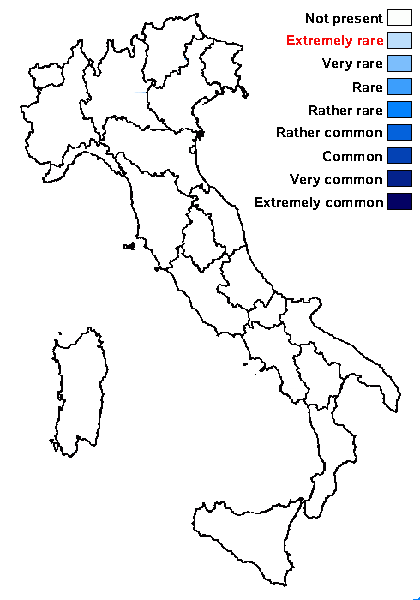Gyalecta mediterranea (Nav.-Ros. & Llimona) Baloch & Lücking
in Baloch & al., Lichenologist, 45: 725, 2013. Basionym: Belonia mediterranea Nav.-Ros. & Llimona - Lichenologist, 29: 16, 1997
Synonyms:
Distribution:
Description: Thallus crustose, episubstratic, 0.3-0.5 mm thick, ecorticate, flesh-coloured to pale ochraceous, continuous or slightly rimose-areolate, the areoles 0.5-1(-1.5) mm wide, the sterile ones flat, the fertile ones convex. Ascomata perithecioid, immersed in thalline warts, globose, (0.2-)0.3-0.5(-0.6) mm wide, opening through a depressed apical pore, usually paler than thallus (sometimes darker near the pore). Proper exciple 2-layered, colourless or pale yellow in lower part (due to the presence of oil cells), 70-80 μm thick in median and basal parts, somewhat thicker near the apex, prosoplectenchymatous; hymenium colourless, I+ blue rapidly turning red-brown; paraphyses mostly simple, thread-like, septate, 1.5-2 μm thick, the apical cells not swollen. Asci (6-)8-spored, narrowly cylindrical, thin-walled, without apical thickenings, the wall K/I+ blue. Ascospores 22-38-transversally septate (rarely with 1 longitudinal septum in 1-3 cells), not or only very slightly constricted at septa, hyaline, acicular with attenuated ends, (55-)65-115 x 4-5.5 μm, the cells isodiametrical or lenticular. Photobiont trentepohlioid. Spot tests: K-, C-, KC-, P-, UV-. Chemistry: without lichen substances.Note: a rare, probably Mediterranean species of shaded limestone rocks, whose ecology resembles that of Gyalecta thelotremella and Lithothelium triseptatum, known from coastal situations of the Iberian Peninsula, to be looked for in Mediterranean Italy.
Growth form: Crustose
Substrata: rocks
Photobiont: Trentepohlia
Reproductive strategy: mainly sexual
Most common in areas with a humid-warm climate (e.g. most of Tyrrenian Italy)

Predictive model
Growth form: Crustose
Substrata: rocks
Photobiont: Trentepohlia
Reproductive strategy: mainly sexual
Most common in areas with a humid-warm climate (e.g. most of Tyrrenian Italy)

Predictive model
 Index Fungorum
Index Fungorum
 GBIF
GBIF

